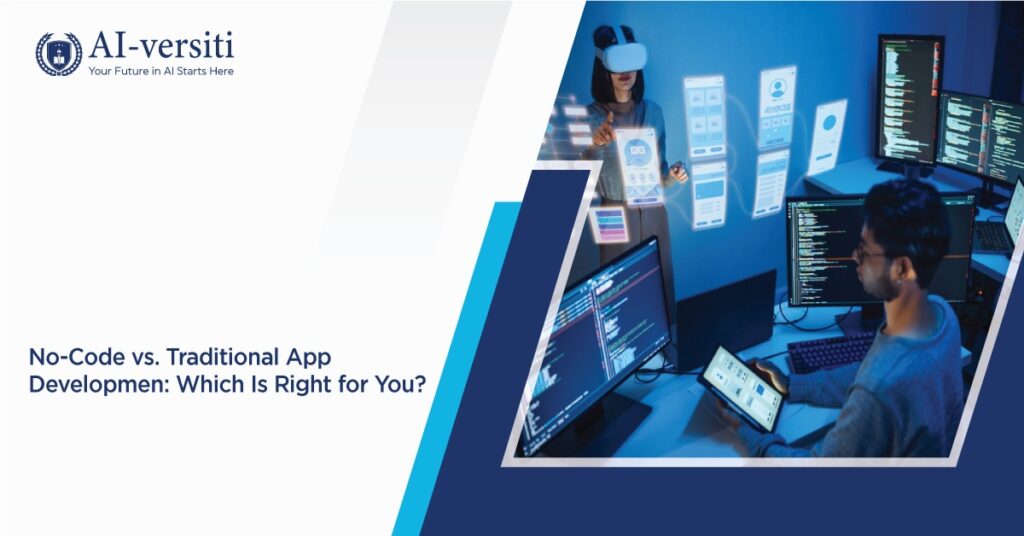In today’s fast-paced digital landscape, app development has become more accessible than ever. With the rise of no-code tools, individuals and businesses can create apps without the need for extensive coding knowledge. But how does no-code app development compare to traditional methods? In this article, we’ll explore the key differences, benefits, and limitations of both approaches, helping you determine which is best suited for your needs.
What is No-Code App Development?
No-code app development allows users to build mobile or web applications without writing a single line of code. Using drag-and-drop app builders, users can design and deploy apps through an intuitive interface. This approach is powered by visual programming, making it ideal for citizen developers—individuals without a technical background.
Understanding Traditional App Development
Traditional app development involves writing code from scratch using programming languages like Java, Python, or Swift. While this method offers complete customization and flexibility, it often requires a team of skilled developers, a significant time investment, and a larger budget.
Key Differences Between No-Code and Traditional Development
1. Development Speed
- No-Code: Enables rapid app development with pre-built templates and automated workflows.
- Traditional: Often time-intensive due to the need for coding, debugging, and testing.
2. Cost Efficiency
- No-Code: Cost-effective as it eliminates the need for a full development team.
- Traditional: Expensive due to high labor costs and infrastructure requirements.
3. Customization
- No-Code: Limited customization due to predefined templates.
- Traditional: Offers unparalleled flexibility to meet specific business needs.
4. Skill Requirements
- No-Code: Designed for non-technical app creation by users with no coding background.
- Traditional: Requires skilled developers proficient in programming languages.
Advantages of No-Code Tools
- Ease of Use: Platforms like cloud-based app builders make app development simple and accessible.
- Faster Time to Market: Ideal for rapid app development and quick iterations.
- Reduced Costs: Lowers the barriers to entry for startups and small businesses.
- Empowers Citizen Developers: Encourages innovation by enabling anyone to build apps.
- Focus on Business Solutions: Allows businesses to prioritize functionality over technical complexity.
When to Choose Traditional Development
Traditional app development shines when:
- You need advanced customization.
- Your app requires integration with complex systems.
- Scalability and high performance are top priorities.
For large-scale projects or specialized needs, traditional methods provide the control and flexibility that low-code/no-code software may lack.
Popular No-Code Platforms
- Bubble: Perfect for building web apps with rich functionality.
- Zapier: Simplifies workflow automation tools and app integrations.
- AppGyver: Tailored for DIY app development with a user-friendly interface.
These platforms demonstrate the versatility of no-code tools, making them ideal for custom app building without coding expertise.
Challenges of No-Code App Development
- Limited Scalability: Pre-defined structures may restrict large-scale expansions.
- Customization Constraints: Templates may not cater to all unique requirements.
- Security Concerns: Ensuring data privacy can be challenging on shared platforms.
Combining No-Code with Traditional Development
The hybrid approach of combining low-code platforms with traditional methods can address limitations. For example, businesses can use app prototyping platforms for quick mock-ups, then hand over development to programmers for advanced features.
Applications of No-Code Development
1. Business Process Automation
Using code-free development solutions, businesses can automate workflows, improving efficiency and reducing human error.
2. Mobile and Web App Creation
From e-commerce to service-based platforms, no-code tools simplify the process of designing mobile app development and web app creation.
3. SaaS App Development
Build SaaS app development platforms without extensive technical expertise, saving time and resources.
Future of No-Code Tools in AI and Beyond
As AI technology advances, no-code tools are integrating features like predictive analytics and machine learning. These innovations are making it easier for businesses to harness AI’s power without technical barriers.
For example, platforms like AIversiti’s no-code courses empower learners to build AI-powered apps without coding. Discover more here.
Internal and External Resources
- Internal Link: Learn about AI-powered app development at AIversiti.
- External Link: Explore insights into no-code platforms from Forbes.
Conclusion
Whether you choose no-code app development or traditional methods depends on your specific needs. No-code tools offer speed, cost savings, and accessibility, while traditional development provides unparalleled customization and scalability. By understanding your project requirements, you can make an informed decision and leverage the best of both worlds.
FAQs
1. What is the difference between no-code and low-code platforms?
No-code tools require no coding knowledge, while low-code platforms may involve minimal coding for advanced customizations.
2. Can no-code tools handle complex app requirements?
No-code platforms are suitable for simple to moderately complex apps but may struggle with highly specialized tasks.
3. Are no-code apps secure?
Security varies by platform. Choose reputable cloud-based app builders with robust data protection features.
4. How much does no-code development cost?
Costs depend on the platform, but it’s generally more affordable than traditional development.
5. Can no-code tools support business process automation?
Yes, they excel at automating workflows using workflow automation tools.
Unlock the future of app development today with no-code tools! Visit AIversiti for expert guidance.

